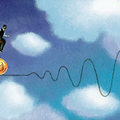GREENWICH, Conn.
IN terms of sheer speed, power and history-making levels of engineering excess, the Bugatti Veyron is a success. Bugatti’s parent, Volkswagen, set out to build the fastest production car in the world, and it did. There is a photo of the thing right there in the 2007 edition of the Guinness Book of World Records, under the heading, Fastest Production Car. It is said to achieve a top speed of 253 miles an hour, and that’s faster than any production car ever.
But here’s the problem with setting out to conquer a superlative: there’s always someone lurking around the corner, drawing a target on your back. Ask the Petronas Twin Towers (at 1,483 feet, the world’s tallest buildings for six years, until the Taipei 101 tower went to 1,671 feet in 2004). Or Hank Aaron.
Once the bar is moved, you’re a historical footnote. That might be why, despite a total run of only 300 cars, half of the Bugatti Veyrons scheduled for production are still unsold.
Oh, sure, the price might be a factor, too. The Veyron is rather expensive — about $1.4 million, although sometimes the price is quoted at $1.3 million or $1.5 million, depending on the exchange rate. (At this level, the price should be quoted in terms of a larger monetary unit anyway, like Ferrari F430s or Christie Brinkley divorce settlements.)
As bad as this may make you feel about your own financial situation, the world has plenty of big-money car nuts with $1 million-plus to spend on a Veyron. But so far, despite fawning reports in the media, buyers have given it a lukewarm reception. The problem, from my point of view, is that the world’s most expensive car comes from the people’s car company, and I suspect that the Veyron is ultimately the VW Phaeton of the supercar stage: Its engineering is beyond reproach, but its origins don’t satisfy the brand snobs who have the money to buy one.
If you own a VW Passat with the W8 motor, then you own half of a Veyron engine, minus the turbos. That’s a fantastic bragging right for the Passat owner, but not so great for the person who just spent the equivalent of seven Ferrari F430s to buy a Veyron.
Certainly, Bugatti is one of the most esteemed European marques ever. But count me among the people who fail to understand the trend of reviving long-dead prestige brands. You’ve got to earn a reputation, not dust one off. There is no authenticity without continuity.
Yet Bugatti, along with Maybach and Spyker, seem to believe that there’s no statute of limitations on the brand appeal of pre-World War II automakers. Hoping that buyers will embrace a supercar because it wears a once-glorious badge is like hoping people will assume your son’s a great baseball player because you named him Honus Wagner.
One wonders why, since VW already owns Bentley, the Veyron doesn’t simply wear the Flying B. What would be so wrong if the world’s fastest car were a Bentley — and might it have sold better that way?
I suppose time, and some distant Pebble Beach lawn event, will tell whether the Bugatti Veyron is as successful with collectors as it is at decimating speed records. What is undebatable right now is that the select few who own (or lease) a Veyron hold the keys to the world’s greatest automotive thrill ride.
Depending on your prior exposure to big-horsepower cars, the initial second of acceleration might not seem out of the ordinary — even with all-wheel-drive, a car has only so much traction off the line, and a Porsche 911 Turbo can spin all four tires out of the gate, too.
But quickly, almost too quickly for your brain to process, the Veyron speeds straight out of your frame of reference. Once the Veyron’s hooked up and putting its 1,001 horsepower to the ground, there’s no comparison I can invoke that will help you understand it, unless you’re a Navy fighter pilot or a circus clown with extensive cannon experience.
When you floor the throttle of the Veyron on the highway, the sensation is as if every other driver slammed on the brakes. Except they didn’t. They’re still doing 70 miles an hour, but you’re blurring the space between the guardrails like an antiproton in a particle collider.
In most cars, you expect a reduction in acceleration as you move up through the gears — longer gear ratios and aerodynamic drag eventually trump horsepower. But the Veyron is different. First gear is quick and violent. Second gear takes slightly longer but seems equally violent. By third gear, you’re worried about your driver’s license and your life, and the thrust shows no sign of relenting. (Did I mention the violence?)
Mission control, something is wrong. The booster rockets don’t seem to be dropping off.
So you hit the brakes and discover that they’re excellent, but they’re of the realm of mortal cars, unlike the motor. Thanks to active aerodynamics and the wonders of downforce, at higher speeds the Veyron’s stopping and cornering power begin to approach the standard set by its go-power.
But by higher speeds, I definitely mean faster than I cared to drive in suburban Connecticut. For example, if you hit the brakes and look in the rearview mirror to see the spoiler extended high and angled down in air-brake mode, you’d better hope there are no constables nearby, because that trick doesn’t come out of the bag unless you’re going at least 130 m.p.h.
I was informed of this by none other than Pierre-Henri Raphanel, a Bugatti test driver, who was riding shotgun at the time and probably had little desire to see the air brake in action on the Merritt Parkway.
Mr. Raphanel, a former racecar driver, knows as much about this car as just about anyone; he also knows what a monumental headache it was to make the Veyron a reality.
The Michelin tires had to be developed specifically for this car. Engineers faced endless setbacks in dissipating the volcanic heat of the motor, which sits naked behind the passenger compartment, a W16 al fresco. The optics of the windshield require such perfection that for every 100 windshields produced, only 5 are usable. The rest, I suppose, go to Crazy Al’s Slightly Irregular Windshield Warehouse.
The gist of Mr. Raphanel’s spiel is that cranking out 1,001 horsepower is just the first of many challenges in building a 253 m.p.h. automobile. In fact, even attempting such a thing is ambitious bordering on crazy.
“Ferrari would never build a car like this,” he said. “They simply don’t need to. They could give a car 700 horsepower and sell out a production run of 400. So why bother going to all the trouble to make it 1,000 horsepower?
“Nobody else will ever make a car like this again. This will be the high point for cars powered by an internal combustion engine.”
I hear you, Pierre, but you know that at some car company, somewhere, there’s a chalkboard emblazoned with a new target: 254 m.p.h.
Already, you can walk into Exotic Cars at Caesar’s Palace in Las Vegas and put your money down on a Koenigsegg CCX, which has a claimed top speed of “245-plus miles per hour.”
Bugatti has sold 150 Veyrons because the car holds the record for the world’s fastest production automobile. And they haven’t sold the other 150 because records are made to be broken.
INSIDE TRACK: The ultimate car — so far.






